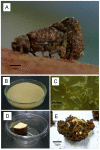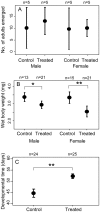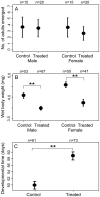Biological role of Nardonella endosymbiont in its weevil host
- PMID: 20957033
- PMCID: PMC2948499
- DOI: 10.1371/journal.pone.0013101
Biological role of Nardonella endosymbiont in its weevil host
Abstract
Weevils constitute the most species-rich animal group with over 60,000 described species, many of which possess specialized symbiotic organs and harbor bacterial endosymbionts. Among the diverse microbial associates of weevils, Nardonella spp. represent the most ancient and widespread endosymbiont lineage, having co-speciated with the host weevils for over 125 million years. Thus far, however, no empirical work on the role of Nardonella for weevil biology has been reported. Here we investigated the biological role of the Nardonella endosymbiont for the West Indian sweet potato weevil, Euscepes postfasciatus. This insect is an experimentally tractable pest insect that can easily be reared on a natural diet of sweet potato root as well as on an agar-based artificial diet. By larval feeding on an antibiotic-containing artificial diet, Nardonella infection was effectively eliminated from the treated insects. The antibiotic-treated insects exhibited significantly lighter body weight and lower growth rate than the control insects. Then, the antibiotic-treated insects and the control insects were respectively allowed to mate and oviposit on fresh sweet potatoes without the antibiotic. The offspring of the antibiotic-treated insects, which were all Nardonella-negative, exhibited significantly lighter body weight, smaller body size, lower growth rate and paler body color in comparison with the offspring of the control insects, which were all Nardonella-positive. In conclusion, the Nardonella endosymbiont is involved in normal growth and development of the host weevil. The biological role of the endosymbiont probably underlies the long-lasting host-symbiont co-speciation in the evolutionary course of weevils.
Conflict of interest statement
Figures




Similar articles
-
Diversity and dynamics of endosymbionts in a single population of sweet potato weevil, Cylas formicarius (Coleoptera: Brentidae): a preliminary study.J Insect Sci. 2023 Mar 1;23(2):13. doi: 10.1093/jisesa/iead021. J Insect Sci. 2023. PMID: 37052365 Free PMC article.
-
Small genome symbiont underlies cuticle hardness in beetles.Proc Natl Acad Sci U S A. 2017 Oct 3;114(40):E8382-E8391. doi: 10.1073/pnas.1712857114. Epub 2017 Sep 18. Proc Natl Acad Sci U S A. 2017. PMID: 28923972 Free PMC article.
-
Effects of Storage Periods of an Artificial Larval Diet on the Yield and Quality of Mass-Reared West Indian Sweet Potato Weevil (Coleoptera: Curculionidae).J Econ Entomol. 2020 Dec 9;113(6):2613-2618. doi: 10.1093/jee/toaa190. J Econ Entomol. 2020. PMID: 32886105
-
What can a weevil teach a fly, and reciprocally? Interaction of host immune systems with endosymbionts in Glossina and Sitophilus.BMC Microbiol. 2018 Nov 23;18(Suppl 1):150. doi: 10.1186/s12866-018-1278-5. BMC Microbiol. 2018. PMID: 30470176 Free PMC article. Review.
-
Antimicrobial peptides and cell processes tracking endosymbiont dynamics.Philos Trans R Soc Lond B Biol Sci. 2016 May 26;371(1695):20150298. doi: 10.1098/rstb.2015.0298. Philos Trans R Soc Lond B Biol Sci. 2016. PMID: 27160600 Free PMC article. Review.
Cited by
-
Impacts of Antibiotic and Bacteriophage Treatments on the Gut-Symbiont-Associated Blissus insularis (Hemiptera: Blissidae).Insects. 2016 Nov 3;7(4):61. doi: 10.3390/insects7040061. Insects. 2016. PMID: 27827869 Free PMC article.
-
Effects of feeding on different parts of Ailanthus altissima on the intestinal microbiota of Eucryptorrhynchus scrobiculatus and Eucryptorrhynchus brandti (Coleoptera: Curculionidae).Front Microbiol. 2022 Aug 4;13:899313. doi: 10.3389/fmicb.2022.899313. eCollection 2022. Front Microbiol. 2022. PMID: 35992686 Free PMC article.
-
Dynamics of Insect-Microbiome Interaction Influence Host and Microbial Symbiont.Front Microbiol. 2020 Jun 26;11:1357. doi: 10.3389/fmicb.2020.01357. eCollection 2020. Front Microbiol. 2020. PMID: 32676060 Free PMC article. Review.
-
Genome shrinkage and loss of nutrient-providing potential in the obligate symbiont of the primitive termite Mastotermes darwiniensis.Appl Environ Microbiol. 2012 Jan;78(1):204-10. doi: 10.1128/AEM.06540-11. Epub 2011 Oct 21. Appl Environ Microbiol. 2012. PMID: 22020505 Free PMC article.
-
Bacteriome-Associated Endosymbiotic Bacteria of Nosodendron Tree Sap Beetles (Coleoptera: Nosodendridae).Front Microbiol. 2020 Oct 29;11:588841. doi: 10.3389/fmicb.2020.588841. eCollection 2020. Front Microbiol. 2020. PMID: 33193249 Free PMC article.
References
-
- Bourtzis K, Miller T. Boca Raton: CRC Press; 2008. Insect symbiosis. Volume 3.384
-
- Moran NA, McCutcheon JP, Nakabachi A. Genomics and evolution of heritable bacterial symbionts. Ann Rev Genet. 2008;42:165–190. - PubMed
-
- Werren JH, Baldo L, Clark ME. Wolbachia: master manipulators of invertebrate biology. Nat Rev Microbiol. 2008;6:741–751. - PubMed
-
- Buchner P. New York: Wiley Interscience; 1965. Endosymbionts of animals with plant microorganisms.909
Publication types
MeSH terms
Substances
LinkOut - more resources
Full Text Sources
Miscellaneous

